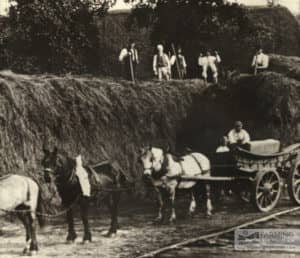Andrew Groves on haymaking
“When I first remember, it was swept in loose. ‘Cos that (looking at photograph) that rick there, that’s a loose rick of hay. It’s about the last one that was ever put up. It was loose, and it was badly weathered in 1958. We never used it.
“Every time we tried to give it to the cows, the milk nearly disappeared and that year hay was … fodder was terribly short. We’d had a dry summer ‘cos I can remember when we cut the cut the corn, we didn’t bother to stand a lot of it up, we just threw it into rows and picked it up. It was dry enough to cart, you know.
“We were there threshing and Mr Isles came out from Newport to buy some corn and I said, “Do you want any hay?” “Yeah, where is it?” So I pointed to this rick and it was getting dark, sort of November time and he pulled a bit out of there and liked at it. He said, “How much do you want for this?” I said, “Fourteen pounds a ton.” “Well as soon as you’ve finished threshing,” he said, “Get on and bale it up.” Well we threshed out some more corn and he came out to buy the corn. He said, “Let’s have another look at that hay” and I thought, Oh God, here we go. He pulled out and looked at it and he looked at me and he said, “Best time to sell this is in the dark, isn’t it?” (laughs).
“But, you know, fourteen pound a ton, that was … wages were a bit more than seven pound a week but that’s nearly two weeks wages for a ton of hay. Well that was a hell of a price.”







